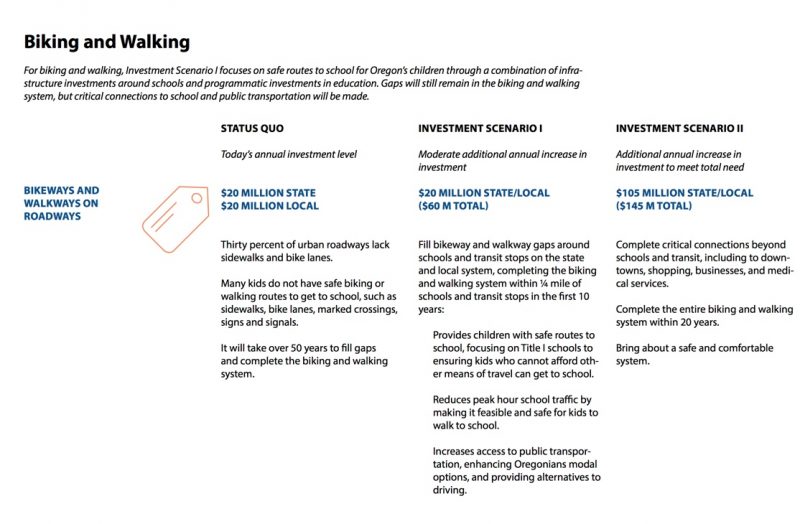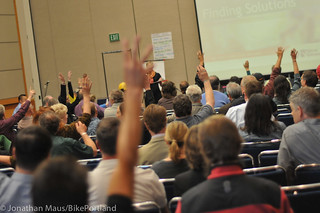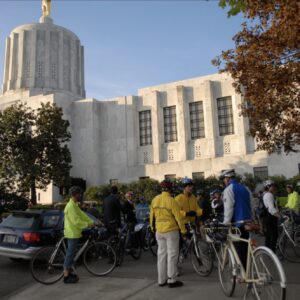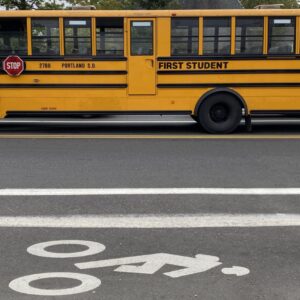
(Photo: J. Maus/BikePortland)
(Note: This article is written by Gerik Kransky, policy director for The Street Trust (formerly the Bicycle Transportation Alliance). It’s the first in a three-part series about their work on a major funding package that will be debated during the 2017 Oregon legislative session.)
Today kicks off the 2017 Oregon legislative session, and Oregon is heading toward adoption of the first major transportation funding package since 2009. The Street Trust and our partners are hard at work to make sure that any major transportation bill includes Vision Zero, Safe Routes to School, and bicycle, pedestrian and transit funding.
We consistently hear our communities’ concerns about the lack of safe streets, the need for increased transit service, the growing amount of carbon emissions from cars and trucks, and the need for stronger safety investments in Vision Zero programs. All of these issues are under discussion with legislative leaders and Governor Kate Brown this year.
In this three-part series, we’ll dig in deeper to talk about who’s in charge of this process; what we can expect in the next six months; and where there are real opportunities to improve safety, health, and environmental outcomes through transportation investments.
How we got here
In late 2015, Governor Brown assembled a team to draft the Governor’s Transportation Vision Panel report, which provides a framework for how much Oregon should invest in different modes of transportation. The report includes some of our top priorities like transit, safety and safe routes to school. After its publication in May 2016, the report became a starting point for a newly formed legislative workgroup (the Joint Interim Committee on Transportation Preservation and Modernization), tasked with writing a bill.
With the Governor’s Vision Report in hand, the Committee spent summer 2016 touring the state; talking to Oregonians about their top priorities; and assembling a long list of interested parties, potential projects, and policy areas needing attention. Finally, the Oregon Department of Transportation itself (via the Oregon Transportation Commission) has put forward a draft investment strategy (PDF) that provides more detail within the framework of the Governor’s report.

Along with several leading transportation stakeholders, The Street Trust has been working in the Oregon Transportation Forum, to put forward a consensus-based slate of recommendations to the legislature, which hits on many of the same themes included in all of these overlapping efforts.
When we consider how many people have been working on this package—over the last year-and-a-half, Oregon is in the best position to pass policy improvements and transportation funding, since the highway-heavy Jobs and Transportation Act of 2009.
Advertisement
What to look forward to in 2017
As a coalition, we’ve been working with legislators and people all across the state, to ensure that we have the support we need to win at least $161 million worth of annual funding for these priorities.
Oregon has a strong coalition of progressive partners, including: The Street Trust, Oregon Environmental Council, OPAL Environmental Justice Oregon, 1000 Friends of Oregon, Transportation for America, Better Eugene-Springfield Transit, the Oregon Conservation Network, and many others. Together, we are all focused on winning the following key priorities in the 2017 transportation package:
- A new state and/or local revenue source for transit needs, to be included in the transportation package;
- A statewide youth transit program to fund transit passes and improved transit service, expanding youth access to schools, jobs and other opportunities;
- Set a statutory goal of zero serious traffic and work zone injuries and fatalities by 2035; and establish a broad task force designed to help build consensus around shared safety goals that focus on policy, roadway improvements, outreach and enforcement;
- Expand the Safe Routes to School program to build safe places to walk, bike, and access transit to school, prioritizing Title 1 schools where a majority of students are eligible for free and reduced lunch. Prioritize the completion of Safe Routes to School Plans, ensuring adequate education funding and building bundled capital projects;
- Identify new revenues for biking and walking safety projects, inside and outside the highway right-of-way;
- Increase state funding for planning and projects that achieve greenhouse gas emissions reduction goals;
- Support the purchase of zero emission electric vehicles;
- Ensure Oregon Department of Transportation (ODOT) management structure and spending decisions are transparent and accountable to Oregonians; and
- In order to maximize accountability, transparency, and return on investment, utilize principles from project prioritization, least cost planning and practical design.
As a coalition, we’ve been working with legislators and people all across the state, to ensure that we have the support we need to win at least $161 million worth of annual funding for these priorities.
Because any transportation package will raise revenue, the mechanics of the Oregon Legislature requires a supermajority of support—in both the House and the Senate—in order to pass the bill. Therefore, any successful package will have to be a bipartisan, in order to win 36 votes in the House and 18 votes in the Senate; this means our work is far from over.
How you can help
Now is the time to have conversations with your legislators around the importance of investing in new transit, safety, safe routes to school, and bicycle and pedestrian infrastructure. In the coming months, you will need to follow up your conversations with legislators to remind them how important this transportation package is and attend the hearings (currently scheduled on Mondays and Wednesdays from 5:30 p.m. to 7:30 p.m.) at the Capitol in Salem.
We need you to deliver testimony and share your personal story—about why you want to see safe streets—and convince the Oregon Legislature to invest.
To stay informed throughout legislative session, we invite you to sign up to receive our advocacy alerts. The Street Trust, and our coalition partners, want all of our members and supporters to receive up-to-date information about how to stay involved.
This effort has been going on for a long time, and we have the broadest levels of support for biking, walking, transit, and safe routes to school that I have seen in over a decade of doing this work. Please join us — and make your voice heard — during the 2017 Oregon Legislature; this is our chance to win $161 million in funding for safer streets!
In Part 2 of this series, we’ll the share the details of the above goals. In Part 3, we’ll provide a deeper look into the For Every Kid Coalition’s grassroots campaign — working with partners across the state to host Safe Routes to School town hall meetings and fighting to increase funding for Safe Routes to School.
— Gerik Kransky, Policy Director, The Street Trust
BikePortland is supported by the community (that means you!). Please become a subscriber or make a donation today.







Thanks for reading.
BikePortland has served this community with independent community journalism since 2005. We rely on subscriptions from readers like you to survive. Your financial support is vital in keeping this valuable resource alive and well.
Please subscribe today to strengthen and expand our work.
I don’t see any mention of allocating funds for traffic law enforcement. In my experience, how safe a road is depends much more on the behavior of the people driving cars than on any other single factor. The one sure way to change that behavior is to enforce our traffic laws, but we haven’t been doing that anywhere in the state. Perhaps not surprisingly, roadway deaths were up 56% between 2013 and 2016.
Thanks for posting this, love to see the street trust and bikeportland collaborating 🙂
You have heard this from me before, but the only way to get to zero motor vehicle induced traffic deaths is to stop having motor vehicle traffic.
Otherwise, we could greatly reduce such deaths, surely, but zero deaths are impossible. And fewer people would die or be maimed if we approached the problem of motor vehicle traffic realistically, rationally, mathematically.
The hyperbolic public relations flim-flam of “Vision Zero” is great for amplifying egos in the wonderful world of non-profits and governmental service, but at the cost of more traffic deaths over any period of time one cares to contemplate.
Ask Kransky this: how would “Vision Zero” eliminate the recent death of a plunge over Barbur down to I5, the probable cause of which was a medical emergency of the driver? “ZERO” means “NONE.”
All those upper middle class emotional white liberal extraverts smiling and waving signs in the leading photo are a large part of our problem. Do the math. They cannot.
I like this one: Identify new revenues for biking and walking safety projects, inside and outside the highway right-of-way;”
Ummm, new streams? So, property taxes, gas taxes and every other tax that flows from cities and Salem isn’t enough for something that EVERYONE participates in?
Real leadership there.